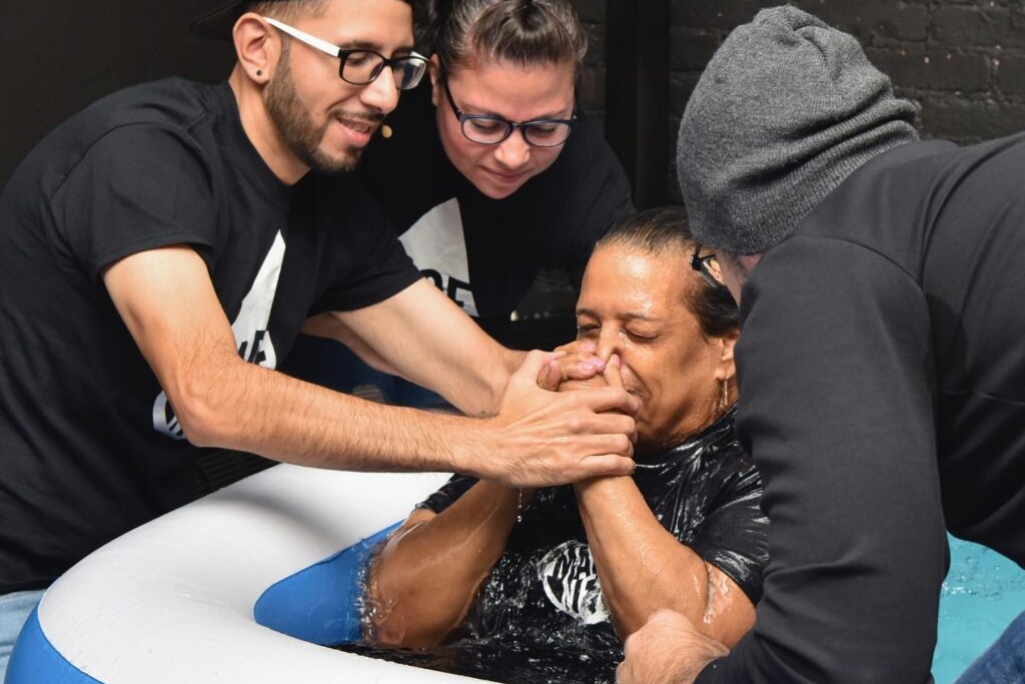
Danny Torres, who was born and raised in the Bushwick neighborhood of Brooklyn, N.Y., baptizes a new believer. Torres planted Swerve Church in his community in 2016 as part of Send Network, the church planting arm of the North American Mission Board.
NASHVILLE (BP) – When asked about online chatter that claimed over half of its affiliated churches had left, Acts 29 responded that those reports are “extremely exaggerated.”
The group, which is not directly connected to the Southern Baptist Convention but counts numerous Southern Baptist churches as part of its network, told Baptist Press in a statement that it expects its partnership renewal process to finish in early May. The number of churches was at 428 when the process began on March 1. As of April 22, it stood at 397 with a small number of churches yet to respond.
There were 486 Acts 29 churches in the U.S. and Canada at the end of 2022, its last renewal period, the statement said.
“Though there is a relational loss that occurs when formal partnerships end, Acts 29 and its leaders remain committed to gospel friendship and kingdom partnership with those who are no longer a part of our network,” it read.
When Acts 29 began in 1998 and grew throughout the 2000s, it became attractive to young pastors because of things like a sense of brotherhood alongside resources for coaching and assessment. Its presence in Southern Baptist life continued to gain momentum as did the platform of its co-founder, Seattle pastor Mark Driscoll.
Fractures formed, though. In December 2007 the Missouri Baptist Convention voted to de-fund Acts 29 churches over alcohol usage. The future of the SBC was a hot topic at the 2009 annual meeting in Louisville, where messengers authorized the appointment of the Great Commission Resurgence Task Force. Meanwhile, five motions directly or indirectly related to Driscoll.
Driscoll was eventually removed in August 2014, almost two and a half years after Texas pastor Matt Chandler became Acts 29 president.
In April 2015 Send Network was launched out of the North American Mission Board. That came out of the Send Cities initiative and was in response to the GCR Task Force’s recommendation for more church plants, Send Network director Noah Oldham told Baptist Press.
Southern Baptist networking
“Over the years that grew as a national strategy throughout the states,” Oldham said. “Church planters had something of a brotherhood, where they could connect with each other and have some guard rails and values within the wider guard rails of the Baptist Faith and Message.”
Southern Baptists began to engage more directly with church planting in the 1940s, looking to establish congregations outside the South as soldiers returned from war and America began developing a booming economy. However, its roots go back further.
“Church planting has been a part of the home mission efforts of the SBC since its formation,” said Luke Holmes, Southern Baptist historian and pastor of Immanuel Baptist Church in Duncan, Okla. “In the beginning the focus was on rural and ‘destitute’ places. Over time that focus has evolved to anywhere people are and a church is needed, like in today’s Send Network strategy.”
Today, Send Network has roughly 4,700 churches that self-identify as a supporting or sending church and just over 1,600 endorsed church planters, Oldham said. Supporting a church can involve a pledge to pray and extend to giving financial assistance. Those steps begin with a church leader going to a portal on the Send Network website and clicking through options.
The Pillar Network is another example of a group that isn’t directly affiliated with the SBC but has a heavy dose of Southern Baptist involvement. Executive Director Nate Akin is the founder and current director of Baptist21 and earned his M.Div degree from Southeastern Baptist Theological Seminary, where his father Danny is president.
On its website Pillar describes itself as “a community of SBC and International Baptist Churches that are doctrinally aligned, missionally driven and committed to equipping, planting, and revitalizing churches, TOGETHER.”
Pillar Network began in 2008 as a grassroots movement by Southern Baptist church planters Bill Curtis and Dwayne Milloni, who focused on church revitalization. It began with three main sending churches and a couple of church plants, but currently has 470 partnering churches in 35 countries.
That partnership includes 52 sending churches that have planted approximately 180 churches, alongside revitalizing or replanting 46 churches, the group told Baptist Press in an email.
Proper alignment
“In the U.S., all of our network churches are required to be a part of the SBC,” the statement from Pillar said. “Additionally, Pillar churches lean reformed and share a similar ecclesiology.”
Matters of theological and governance agreement factor when it comes to church planting networks. Those issues are at the forefront of discussions about a drop in Acts 29 affiliated churches or the compatibility of churches in Send Network.
“They have to agree to the Baptist Faith and Message and desire to be a cooperating Southern Baptist church,” Oldham said. “Our field staff work as advisers, but those churches are still under the auspices and leadership of their sending church. We lean on those sending churches to keep those church plants accountable.
“If they choose to move outside the parameters of the Baptist Faith and Message and not believe those things, our only option is to not fund them anymore. Once they are beyond that five-year endorsement season, our prayer is they will become a full SBC church.”
A graphic on the front page of Send Network’s website claims more than 10,000 churches planted across North America by Southern Baptists since 2010. Oldham added that the majority of attendees at the last three Send Network orientations were non-white, pointing to the growing diversity in the SBC.
Also worth mentioning is that the last 15-20 years brought church planters in their 20s and 30s. Oldham has noticed that age range pushing into the 40s.
Partnerships that plant new churches begin with established ones, regardless of the size of the membership roll or budget. Oldham has seen large, contemporary churches as well as small churches that use pews and hymnals be part of the process.
Sending churches are crucial, starting with where the new church is located and continuing its involvement over the following years.
“We lean heavily on the sending church,” Oldham said. “Through the personal call of the planter, combined with the spiritual leadership and oversight of the sending church, God is extending the ministry of the sending church out through church planting.”
(EDITOR’S NOTE – Scott Barkley is national correspondent for Baptist Press.)


